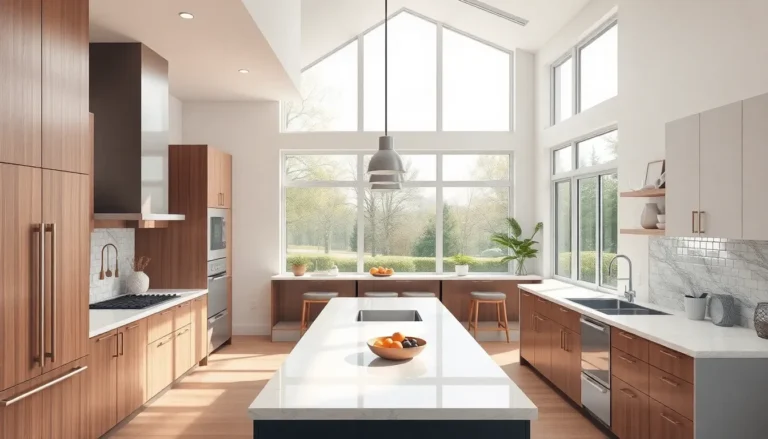Table of Contents
ToggleImagine sipping your morning coffee while basking in the sun, with the fresh breeze flowing through your home. That’s the magic of indoor-outdoor flow—a design trend that brings the outside in and transforms living spaces into serene retreats. It’s not just about aesthetics; it’s about creating a harmonious connection between nature and your cozy abode.
Understanding Indoor-Outdoor Flow
Indoor-outdoor flow connects interior spaces with the outdoors, enhancing both aesthetics and functionality. This design approach creates a seamless transition that invites nature into the home.
Definition and Importance
Indoor-outdoor flow defines the harmonious transition between indoor spaces and outdoor environments. This connection enriches the living experience by incorporating natural light, fresh air, and scenic views. Emphasizing this flow fosters tranquility and can improve mental well-being. It transforms a house into a sanctuary, increasing property value and appeal. Homeowners appreciate the versatility it provides, accommodating both relaxation and entertaining.
Key Elements of Indoor-Outdoor Flow
Key elements include wide openings, shared materials, and consistent color palettes. Sliding glass doors or large windows enhance visibility while allowing easy access to outdoor areas. Utilizing similar flooring indoors and outdoors further strengthens the visual connection. Incorporating greenery, like potted plants or vertical gardens, promotes an organic feel, blurring the lines between spaces. Lighting elements should also be considered, as both indoor and outdoor lights create inviting atmospheres. These aspects collectively promote a cohesive design that elevates both environments.
Benefits of Indoor-Outdoor Flow

Indoor-outdoor flow offers numerous advantages that enhance living experiences. This design trend transforms homes into serene sanctuaries, fostering a deeper connection to nature.
Enhancing Living Space
Enhanced living space reflects a seamless blend between interiors and exteriors. Large glass doors facilitate unobstructed views, creating a sense of openness. Shared materials, such as tiles or flooring, help unify different areas. Consistent color palettes further reinforce this cohesion, making the transition feel natural. Greenery, such as potted plants or garden views, enriches the environment and adds vibrancy. These factors work together to expand usable space, enabling families to enjoy both outdoor and indoor areas simultaneously.
Improving Well-Being
Improving well-being is a key benefit of indoor-outdoor flow. Natural light floods interiors, positively influencing mood and energy levels. Fresh air circulates throughout the home, contributing to better air quality. Scenic views reduce stress and create a tranquil atmosphere, supporting mental health. Elements of nature, like plants and water features, promote relaxation and enhance overall wellness. Emphasizing this connection to nature fosters a serene living environment that nurtures both body and mind.
Design Strategies for Optimal Indoor-Outdoor Flow
Achieving optimal indoor-outdoor flow requires thoughtful design strategies across architectural and landscaping elements.
Architectural Considerations
Maximizing indoor-outdoor flow begins with architectural design. Large glass doors act as gateways, providing expansive views and creating a seamless transition. Installing wide openings enhances airflow, allowing spaces to breathe. Consistent flooring materials between indoors and outdoors create visual continuity. Using similar color palettes ensures harmony, connecting the two areas. Integrating overhangs or awnings protects outdoor spaces from sun and rain while maintaining accessibility. Thoughtful placement of windows invites natural light into deep interior spaces, enhancing overall brightness. Each of these architectural choices plays a crucial role in crafting a cohesive living experience.
Landscaping Techniques
Landscaping further enhances indoor-outdoor flow by extending living spaces into outdoor areas. Incorporating native plants establishes a natural connection to the environment. Pathways that guide visitors from indoors to garden areas create a sense of discovery. Utilizing transitional elements, such as decks or patios, provides structured outdoor rooms for living. Incorporating water features, like ponds or fountains, enhances tranquility with soothing sounds. Adding seating options within landscaped areas promotes outdoor enjoyment. Lighting fixtures can define spaces at night and create ambiance. Every landscaping technique contributes to an inviting atmosphere that blurs the lines between indoor and outdoor living.
Challenges in Achieving Indoor-Outdoor Flow
Achieving indoor-outdoor flow presents various challenges that can impact design and functionality. Understanding these challenges is essential for creating a cohesive living environment.
Environmental Factors
Environmental factors significantly influence indoor-outdoor flow. Weather patterns, including extreme temperatures and heavy rainfall, may limit outdoor use. Sun exposure affects furniture longevity and the comfort of outdoor spaces. Additionally, landscaping elements must consider local wildlife, which can disrupt harmony between spaces. These aspects necessitate careful planning to maintain a balance between aesthetics and practicality.
Practical Limitations
Practical limitations often arise in indoor-outdoor flow projects. Spatial constraints may restrict the size and placement of openings. Budget considerations also play a crucial role; high-quality materials are necessary for seamless integration but can escalate costs. Accessibility concerns may restrict flow for individuals with mobility challenges. These limitations require innovative design solutions to achieve a harmonious connection between indoor and outdoor environments.
Embracing indoor-outdoor flow can transform any living space into a harmonious retreat. By seamlessly connecting the indoors with the outdoors, homeowners can enjoy the tranquility and beauty of nature right from their living rooms. This design trend not only enhances aesthetics but also promotes well-being and increases property value.
With thoughtful architectural and landscaping strategies, achieving this flow becomes attainable, allowing families to maximize their living experience. Despite the challenges that may arise, innovative solutions can create a cohesive environment that balances beauty and functionality. Ultimately, indoor-outdoor flow enriches lives by fostering a deeper connection with nature.




